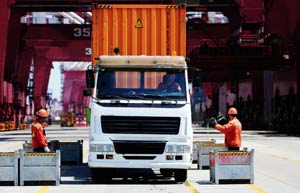No aggressive measures
China's urban unemployment rate was nearly 4.1 percent at the end of June, though many economists believe the real number may be much higher given its army of migrant workers.
The employment index aside, other measures in the PMI poll fared better, which could temper Beijing's policy response for now.
Total new orders rose, and new export orders also climbed to their highest level since March 2010.
The overall output level remained flat on the month, while output prices fell to a six-month low.
The final HSBC/Markit manufacturing PMI for the month is due on Sept 30, with the official reading on Oct 1.
 |
A dramatic increase in reliance on state support starkly illustrates the industrial weakness that is weighing on the economy. Subsidies accounted for four-fifths of the profits reported by Chinese steel companies in the first half of this year, according to a Reuters analysis of corporate financial statements.
"We still expect some more measures to support growth, such as stimulating infrastructure investment, relaxing property market policies and some more monetary easing steps," said Louis Kuijs, an economist at RBS in Hong Kong.
"However, the recent signs of policymakers suggest to us that they will not resort to more significant and higher profile measures unless growth takes another turn for the worse."
Gradual slowdown
Export growth has been unsteady, and the cooling housing market is undermining already softening domestic demand. Recent data showed factory output grew at the weakest pace in nearly six years in August.
Prices for Chinese steel and iron ore futures have slumped to record lows, while oil, copper, rubber and other raw materials have also skidded on fears of slowing China demand, which is rapidly leaving the United States as the only major driver of world economic growth.
Chinese leaders have publicly ruled out another massive stimulus program this year like the one launched during the global financial crisis, but are prepared to take targeted measures supporting the most vulnerable sectors.
Further measures are already being rolled out even as leaders publicly advise caution.
The central bank last week injected money into the country's top banks in a bid to help support the economy by keeping borrowing costs down, and media have reported this week that the "Big Four" banks plan to ease rules on mortgage lending in a move orchestrated by regulators.
"The economy still faces significant headwinds, particularly from the property sector, and our base scenario remains a gradual slowdown in the coming months," Capital Economics said in a note to clients.
